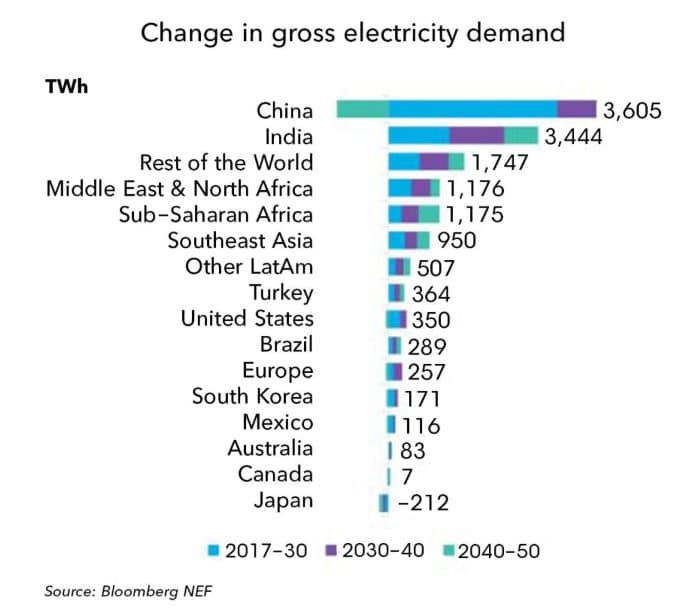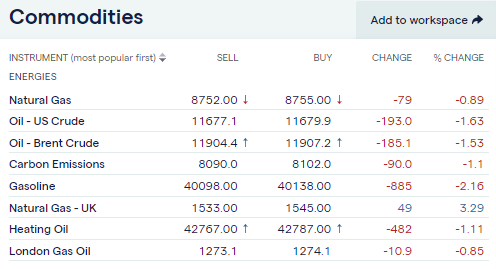Whether you’re thinking about gaining exposure to the energy sector, trading energy commodities or just plain curious, there’s no doubt that energy is big business.
Traders keen to capitalise on the projected future growth of the energy market should also be wary of the volatility that affects this sector. Many people are asking how to trade energy, and there are some key things that you should know first.
How Big is the Energy Market?
In a word: big.
Most of us are familiar with fossil fuels like gasoline and diesel, but the energy market goes well beyond transportation. In addition to fossil fuels, the energy market also incorporates natural gas liquids, electrical power, nuclear power, and renewable energy.
Commodity assets such as crude oil, natural gas, and electrical power are traded around the globe. In addition, the companies that produce, refine, transport, store and consume energy are actively traded on stock exchanges around the world.
Global energy consumption reached 13.86 billion metric tons of oil equivalent in 2018, a figure that has risen by 47% since 2000.

Energy Demand Side – Growth
The IEA also sees total energy demand growing by 25% until 2040 The different segments of the energy markets are expected to see diverging growth patterns in the future. During the next decade, oil growth is expected to continue to climb according to the International Energy Agency (IEA).
Global oil growth demand is expected to increase into the 2030s and then begin to decelerate. The EIA believes that oil demand will increase by about 1 million barrels per day on average every year to 2025, from 97 million barrels per day in 2018.
During the short-term, in the aftermath of the global COVID-19 pandemic, demand is expected to decline significantly. The US Department of Energy (DOE) sees fossil fuel consumption down 7% year over year and expects demand to fall 9% during 2020. The DOE expects energy demand to rebound 5% in 2021.
Natural gas production is also expected to decline in 2020. The DOE sees natural gas production averaging 89.8 BCF per day down 3% year over year from 92.2 BCF per day.
YOUR CAPITAL IS AT RISK
Renewables
Electrical power and renewable energy are sectors that are continuing to expand. The IEA sees renewable energy accounting for half of the rise and natural gas for 35%.
The US Department of Energy reports that U.S. annual energy consumption from renewable sources exceeded coal consumption for the first time in its history in 2019.
This scenario has played out as coal consumption to generate electricity that has dwindled while solar and wind electricity generation has increased.
The EIA believes that coal consumption in the United States decreased by nearly 15%, and total renewable energy consumption grew by 1%. For 2020, EIA expects that coal generation will fall by 25%.
Renewable energy is consumed by every sector in the United States. The majority, approximately 56% of renewable energy is used for electricity, driven by hydroelectric power. Additionally renewables are consumed in industrial, transportation, and residential.
Electricity
The agency believes the increase in electric cars will be a headwind for oil growth and drive electricity growth. The EIA believes that by 2040 there will be 330 million electric cars on the road up from an estimate of 300 million in 2018. That would displace approximately 4 million barrels a day of oil use.
According to Bloomberg, electricity demand will increase by 25% by 2050 to 38,700 terawatt-hours from 25,000 terawatt-hours in 2017. Most of the gains will come from China, closely followed by India. Approximately 9% of electricity demand will be driven by electric cars.

In the short-term, the US Energy Information Administration (EIA) expects US retail sales of electricity in the commercial sector will fall by 6.5% in 2020 because of the quarantine that forced many businesses to close.
Is The Supply Side Ready?
Ahead of the spread of COVID-19 throughout the globe, energy production had been on the rise. In the wake of the pandemic, planned spending in the energy sector had dropped significantly.
The declines occurred as exploration and development planned expenses dropped from a 4-year high. In a low priced trading environment global expenditures can drop significantly.
The Energy Information Administration (EIA) sees expenditures dropping to $10 per BOE from $20 per BOE of oil and gas prices remain at current levels. This follows a 13% increase in 2019 to $361 billion according to the EIA. This will put downward pressure on production. In the United States alone, US crude oil production has declined from 13.1-million barrels of oil per day down to 11.4-million barrels a day from early-March 2020 to mid-May 2020. This represents a 13% drop in output.
This dip was temporary, and brought about by and large by pandemic related issues. There was an oversupply when the world stopped moving, but after a brief pause, the US is now producing more crude oil than ever. The same cannot however be said for Russia and Saudi Arabia, who are slightly down from highs.
Other areas of supply of course now include a broad range of renewables. Through solar, wind, & hydropower, the renewables market is growing, but there remain limitations to catch up with demand. Getting this balance right is of paramount importance.

YOUR CAPITAL IS AT RISK
How to Trade Energy Commodities
The global supply and demand changes for energy present an opportunity to trade these markets. Shocks generally generate price spikes or troughs, which eventually recover, but short-term geopolitical uncertainty is always ready to play a part in disrupting energy market prices.
Several strategies can be used to trade energy products. These include those based on fundamental analysis and evaluating supply and demand or measuring one energy product versus another. A complementary approach uses price data and metrics in the form of technical analysis.
Once your research has given you a good steer on what direction price might head, it’s time to select the instruments and markets best suited to your approach. As the sector is considered high-risk, using ETFs can help smooth out returns and avoid excessive price volatility.
CFDs have added functionality and allow traders to sell short and apply leverage, so they are often used for strategies at the riskier end of the spectrum
The Various Ways To Trade – Futures, ETFs, Stocks, or CFDs?
Two main groups trade energy products. The core trading activity is between oil producers and refiners and users of the finished product, such as airlines, electricity suppliers and chemical manufacturers. If changes in underlying economic activity suggest price might change in the future, speculators can join in the trading activity to buy and sell positions for a profit but with no intention of ever taking delivery of the product being traded
Futures Markets
Fossil fuels such as oil, petrol, heating oil, gas oil, residual fuels, coal, and natural gas are traded on a global basis. Their price is determined by activity on futures exchanges such as the Chicago Mercantile Exchange (CME) and the Intercontinental Exchange (ICE). A futures contract is the obligation to either buy or sell an asset at a pre-determined date in the future. A futures contract has a fixed volume and trades on a regulated exchange.
Global crude oil benchmarks such as the Brent oil futures contract are actively traded on ICE. Brent is a worldwide benchmark with approximately 70% of global crude priced accordingly. ICE also offers a Middle East benchmark, with the other major oil product being the US-based West Texas Intermediate market.
The oil and refined products traded on futures exchanges are financially settled and physically delivered. Many futures contracts provide the option to exchange the financially settled instrument for a physical transaction delivered to an ICE-regulated storage facility. This reflects the futures exchange primarily serving the ‘real’ economy – people who want to take delivery of a quantity of crude as part of their business model.
Trading Electricity
Electricity is a local product that is actively traded in the United States. Since you cannot store electricity for more than a few days (via a battery), the price is driven by demand and the cost of supply. The CME provides several active electricity contracts based on specific locations throughout the United States. Each electricity contract describes the hub where it will be delivered and a specific wattage that will be provided each day.
Speculative Trading of Energy Products
Those trading futures for purely speculative purposes need to avoid trading futures with physical delivery. The worst-case scenario involves staying too long in a position and then being contractually obliged to take delivery of the barrels of oil that were bought. This can be an issue when you consider that the WTI contract traded on the CME is physically delivered. Each contract requires the delivery of 1,000 barrels of WTI crude oil, which equals 42,000 gallons.
The CME also offers petrol contracts, heating oil contracts, brent oil contracts, and coal contracts. More experienced investors can favour futures with enough capital to meet the minimum balance requirements and the knowledge of how to manage ‘roll-overs’ and ensure they avoid trading physical delivery futures.
Online brokers who offer markets in the same energy products make the trading of energy markets more user-friendly. They take a live price feed from the exchange but offer their clients a cash-only product which can be traded in small sizes.
Energy ETFs
Exchange-traded funds (ETFs) are another investment vehicle that online brokers offer. It is a more convenient way to gain exposure to the energy market. This stock-like security is traded on an exchange that allows you to purchase a basket of different energy products. Each ETF outlines products it might invest in, such as futures contracts, indices that track the movement of some underlying asset, or energy stocks. For example, the United States Oil Fund holds WTI futures contracts.
Some ETFs focus on raw material commodities, such as natural gas. Others might invest in exploration and production companies or hold only oil service companies or refiners. You can trade ETFs that hold these companies in a trust. The XLE Spider ETF holds large integrated companies like Exxon Mobile, Chevron Texaco, and Conoco Phillips. Whichever area of the sector you want to invest in, you can buy a basket of different assets with the click of a button.
Energy CFDs
Contracts for Differences (CFDs) are financial instruments that provide exposure to energy. They are private contracts between retail traders and their broker that track the movements of energy products like crude oil, natural gas or an energy company.

Energy Stocks
You can’t buy stock in natural gas or oil, but as stock trading is one of the easiest ways for individual investors to trade, it can be a neat way of gaining indirect exposure to the sector.
Buying shares in an oil producer such as ConocoPhillips (COP) or solar power giant First Solar Inc (FSLR) allows you to benefit from events which impact those companies.
It’s possible to buy shares in companies that produce, refine, move, consume, and store energy. They include:
- Exploration and Production
- Oil and Natural Gas Services
- Refiners
- Pipeline Companies
- Transportation Companies
- Utilities
There are thousands of public companies that engage in these activities. They are listed on stock exchanges throughout the world. Trading fees are low, dividends are always possible, and the exchanges the stocks are traded on are well regulated. Energy stocks are a low-maintenance and cost-effective way for buy-and-hold investors to take a position in the energy market.
There are thousands of public companies that engage in these activities. They are listed on stock exchanges throughout the globe. In addition to trading individual equities, you can trade ETFs that hold these companies in a trust. For example, the XLE Spider ETF holds large integrated companies like Exxon Mobile, Chevron Texaco, and Conoco Phillips. Some CFDs track the movements of some of the large oil companies as well as the ETFs that are actively traded.

The Bottom Line
The global energy sector generally expands during periods of economic growth and contracts during recessions. The spread of COVID-19 had a significant impact on energy demand, which will eventually return. The energy industry is vast covering the fossil fuel sector as well as renewable energy and electricity.
While the short-term outlook is mixed, the long term outlook favors the additional use of electricity as a replacement for fossil fuels. Electricity will likely continue to replace fossil fuels used in transportation as electric cars sales expand.
Underlying energy products such as crude oil, heating oil, gas oil, gasoline, natural gas, ethanol, and electricity are actively traded on the Chicago Mercantile Exchange and the Intercontinental Exchange. Commodity assets such as crude oil, are fungible are traded around the globe while natural gas and electrical power are more localized.
Energy is produced and consumed through energy assets, such as refiners and utilities. Companies like these as well as producers and distributors of energy are traded on stock exchanges worldwide. The energy sector is a massive part of worldwide global commerce and will likely continue to change in the decades to come.










